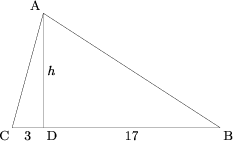Difference between revisions of "1988 AIME Problems/Problem 7"
m (→See also) |
Arcticturn (talk | contribs) (→Solution) |
||
| (16 intermediate revisions by 9 users not shown) | |||
| Line 1: | Line 1: | ||
| − | |||
| − | |||
== Problem == | == Problem == | ||
| + | In [[triangle]] <math>ABC</math>, <math>\tan \angle CAB = 22/7</math>, and the [[altitude]] from <math>A</math> divides <math>BC</math> into [[segment]]s of length 3 and 17. What is the area of triangle <math>ABC</math>? | ||
== Solution == | == Solution == | ||
| + | <center>[[Image:AIME_1988_Solution_07.png]]</center> | ||
| + | |||
| + | Call <math>\angle BAD</math> <math>\alpha</math> and <math>\angle CAD</math> <math>\beta</math>. So, <math>\tan \alpha = \frac {17}{h}</math> and <math>\tan \beta = \frac {3}{h}</math>. Using the tangent addition formula <math>\tan (\alpha + \beta) = \dfrac {\tan \alpha + \tan \beta}{1 - \tan \alpha \cdot \tan \beta}</math>, we get <math>\tan (\alpha + \beta) = \dfrac {\frac {20}{h}}{\frac {h^2 - 51}{h^2}} = \frac {22}{7}</math>. | ||
| + | |||
| + | Simplifying, we get <math>\frac {20h}{h^2 - 51} = \frac {22}{7}</math>. Cross-multiplying and simplifying, we get <math>11h^2-70h-561 = 0</math>. Factoring, we get <math>(11h+51)(h-11) = 0</math>, so we take the positive positive solution, which is <math>h = 11</math>. Therefore, the answer is <math>\frac {20 \cdot 11}{2} = 110</math>, so the answer is <math>\boxed {110}</math>. | ||
| + | |||
| + | ~Arcticturn | ||
== See also == | == See also == | ||
| − | + | {{AIME box|year=1988|num-b=6|num-a=8}} | |
| − | {{ | + | [[Category:Intermediate Trigonometry Problems]] |
| + | {{MAA Notice}} | ||
Latest revision as of 22:25, 20 November 2023
Problem
In triangle ![]() ,
, ![]() , and the altitude from
, and the altitude from ![]() divides
divides ![]() into segments of length 3 and 17. What is the area of triangle
into segments of length 3 and 17. What is the area of triangle ![]() ?
?
Solution

Call ![]()
![]() and
and ![]()
![]() . So,
. So, ![]() and
and ![]() . Using the tangent addition formula
. Using the tangent addition formula ![]() , we get
, we get  .
.
Simplifying, we get ![]() . Cross-multiplying and simplifying, we get
. Cross-multiplying and simplifying, we get ![]() . Factoring, we get
. Factoring, we get ![]() , so we take the positive positive solution, which is
, so we take the positive positive solution, which is ![]() . Therefore, the answer is
. Therefore, the answer is ![]() , so the answer is
, so the answer is ![]() .
.
~Arcticturn
See also
| 1988 AIME (Problems • Answer Key • Resources) | ||
| Preceded by Problem 6 |
Followed by Problem 8 | |
| 1 • 2 • 3 • 4 • 5 • 6 • 7 • 8 • 9 • 10 • 11 • 12 • 13 • 14 • 15 | ||
| All AIME Problems and Solutions | ||
The problems on this page are copyrighted by the Mathematical Association of America's American Mathematics Competitions. 









